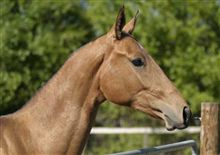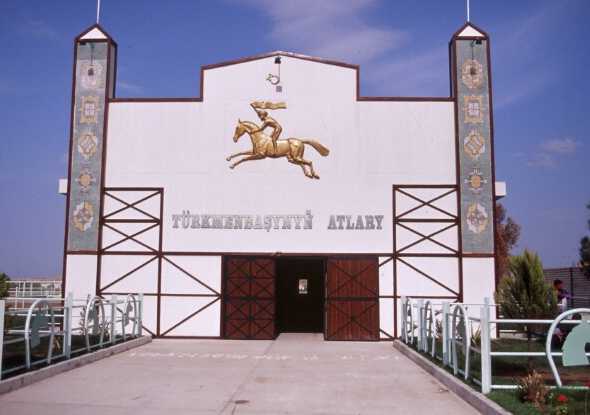Turkmenistan: Legendary Horses Look To Make Comeback
By Julie A. Corwin
 |
| A purebred Ahal-Tekes horse |
| (courtesy photo) |
Horse fanciers in the former Soviet Union have long known about the beauty, speed, and stamina of the Ahal-Teke breed native to Turkmenistan. But despite attempts to spread the word about this breed, the Ahal-Teke remains obscure to most of the rest of the world. A small community in the United States is trying to spread interest across the Atlantic Ocean. But the cause of the horse was dealt a major blow when one of the most talented Ahal-Teke breeders in the world, Geldy Kyarizov, was imprisoned by Turkmen officials in 2002. Today, some of the world's best Ahal-Tekes farms are located not in Turkmenistan but in Russia.
WASHINGTON, 22 September 2006 (RFE/RL) -- Some experts will tell you the Ahal-Teke is the oldest horse breed in the world.
These tall, elegant animals reportedly caught the attention of early explorers -- like Marco Polo and Alexander the Great -- for their ability to cover long distances in the desert with little water.
Nearly a century and a half after their slaughter at Russian hands -- and following more than half a century of the erratic consequences of Soviet policies -- the future of the vaunted Ahal-Tekes looks like it could be decided not in its ancestral home in Turkmenistan, but in Russia.
|
Struggle To Survive
But the Ahal-Tekes have not survived without a struggle.
The Teke tribe, a nomadic people who lived around an isolated oasis in southern Turkmenistan, preserved the horse over the centuries by refusing to allow it to be crossbred.
But when the horse's guardians, the Teke, came under siege in the 19th century, so did the horses.
In the 1870s, the Teke tribe had been successfully resisting the advance of the Russian imperial army in part because of their speedy horses.
Jessica Eile-Keith is an Ahal-Teke breeder based in Florida. She describes what the Russian army decided to do once they came.
"The Russian Army knew the Tekes were difficult to get because of their horses," she said. "So they said, 'If we kill the horses, the Teke won't survive.' And they slaughtered a lot of horses, and after that the breed almost disappeared."
Revival
Almost two decades later, the Russians came to the horses' rescue. In 1897, they established a stud farm. And in the late 1920s, Russian scientists began the stud book for the breed that is still used today. Only horses whose parents are registered in the book can be considered Ahal-Teke.
During the Soviet era, the Ahal-Tekes' fortunes waxed and waned. The horses suffered during the collectivization of agriculture under the Soviets. Some Turkmen owners let them run loose in the desert rather than allow them to become part of big collective farms.
Later, the breed was considered prestigious enough for Marshall Georgii Zhukov to ride in a Moscow victory parade after World War II.
But during the era of Soviet leader Nikita Khrushchev, Eile-Keith says the horses faced a new assault from five- and 10-year economic plans.
"Ahal-Tekes ended up in the slaughterhouse -- like many other good horses -- to fill up the meat quota," she said.
Presidential Support
The current period should offer a respite for the Ahal-Teke.
After all, Turkmen President Sapurmurat Niyazov is reportedly a member of the Teke tribe and considers himself a promoter of the breed. He has been giving them as gifts to world leaders at a furious pace, and spent an estimated $25 million to construct an equestrian center. The entrance to President Niyazov's stables in Ashgabat The entrance to President Niyazov's stables in Ashgabat
But with some 1,000 purebred Ahal-Tekes born each year -- compared to more than 100,000 English thoroughbreds -- the Ahal-Teke arguably needs talented breeders more than publicity and nice stables.
And Eile-Keith would argue that horse breeding is one of the rare professions that involves as much art and passion as science.
"We have today three big names in Ahal-Teke breeding -- [in Stavropol] Aleksandr Klimuk; and we have an upcoming big breeder in the Moscow area, a Daghestani man called Leonid Babaev," she said. "In Turkmenistan, there was the former [head of the state association of horse farms, Turkmenatlar], Geldy Kyarizov, who breeds magnificent Ahal-Teke horses. And he is not breeding horses today due to 'problems.'"
Kyarizov was head of the Turkmenatlar horse farms in 2002 when he was arrested by the Turkmen secret police and sentenced to six years in jail for negligence and abuse of authority. Amnesty International notes that there are allegations that the charges against him were fabricated, and that the true reason for targeting him was that he fell out of favor with President Niyazov.
Water for the farm where about 90 of Kyarizov's horses are living was disconnected this July. The farm is the birthplace of Yanardag (Volcano), one of Kyarizov's champion Ahal-Teke stallions whose profile graces the national emblem of Turkmenistan.
Russian Studs
Eile-Keith says that now the best Ahal-Teke breeders in the world are in Russia. And, the best stud farm is located in Stavropol Krai.
Eile-Keith and her husband, Todd Keith, are raising Ahal-Tekes on their small farm in Florida. While the hot but wet Florida weather is quite a bit different from the dry climate of the Karakum Desert, she says her Ahal-Tekes seem to like it.
They are moving slowly, introducing the breed to the multibillion-dollar, horse-racing industry of Kentucky. Earlier this month, a brown colt sold for more than $8 million in a yearling thoroughbred sale. Ahal-Tekes typically fetch much lower prices -- starting at about $15,000 to $20,000.
Will the Ahal-Tekes ever be valued as highly as English thoroughbreds? Eile-Keith says the current stock of Ahal-Tekes needs to be improved so that they look "like they did when they were in top demand a few hundred years ago."
"That [work] is being done foremost in Russia today to try to recreate the breed to its former greatness. And [today's]...horse market is very competitive. There are very many attractive breeds bred by very, very skillful Western breeders. And if you introduce a new breed, that breed must be high quality horses for these people to even look at them."
So, nearly a century and a half after their slaughter at Russian hands -- and following more than half a century of the erratic consequences of Soviet policies -- the future of the vaunted Ahal-Tekes looks like it could be decided not in its ancestral home in Turkmenistan, but in Russia. |